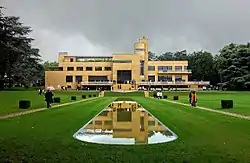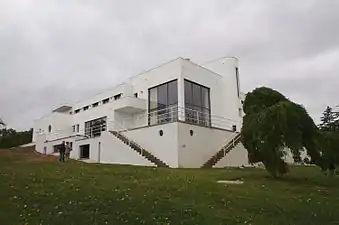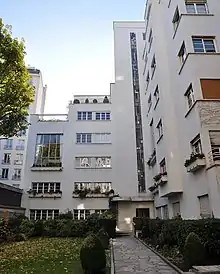Robert Mallet-Stevens
Robert Mallet-Stevens (March 24, 1886 – February 8, 1945) was an influential French architect and designer.
Robert Mallet-Stevens | |
|---|---|
 | |
| Born | March 24, 1886 |
| Died | February 8, 1945 Paris |
| Nationality | French |
| Occupation | Architect |
| Buildings | Villa Cavrois Villa Noailles |

%252C_en_1927.jpg.webp)

Early life
Mallet-Stevens was born in Paris in a house called Maison-Laffitte (designed by François Mansart in the 17th century). His father and his grandfather were art collectors in Paris and Brussels. He received his formal training at the École Spéciale d'Architecture in Paris, during which he wrote Guerande about relationships between the different forms of art.
Career
In 1924 Mallet-Stevens published a magazine called La Gazette Des 7 Arts and at the same time with the help of Ricciotto Canudo founded the Club des amis du 7ème art. A Paris street in the 16th arrondissement, Rue Mallet-Stevens, was built by him in the 1920s and has on it six houses designed by him.[1]
A portfolio of 32 of Mallet-Stevens' designs was published under the title Une Cité Moderne in 1922.[2] In addition to designing shops, factories, a fire station in Paris, apartment buildings, private homes, and interiors, he was one of the first architects to show an interest in cinema. He designed film sets and his design for Marcel L'Herbier's silent film L'Inhumaine (1924) is considered a masterpiece.
In 1929, surrealist photographer and filmmaker Man Ray made a film inspired by his design for the buildings named "Villa Noailles" entitled The Mysteries of the Château de Dé.
During his career he assembled a team of artisans and craftspeople who worked with him: interior designers, sculptors, master glaziers, lighting specialists, and ironsmiths.[3] An example of his collaborative nature is provided by the Union des Artistes Moderne (UAM), formed in 1929 by a group of 25 dissidents of the Société des Artistes-Décorateurs (SAD), and presided over by Robert.
Legacy
Mallet-Stevens ordered that his archives be destroyed upon his death. His wishes were honored and his memory fell into obscurity. A French exhibit of his drawings, models, and actual works at the Centre Pompidou in 2005 sparked public interest in his contributions.
Buildings and projects
- Villa Paul Poiret (1921–1923), in Mézy-sur-Seine completed in 1932
- Villa Noailles (1923–1928), in Hyères
- Villa Cavrois (1929–1932), in Croix
- Rue Mallet-Stevens (1927), Paris:[4][5]
- Garage Alfa Romeo, Rue Marbeuf, Paris
- House of Louis Barillet, Square Vergennes 15, Paris[11]
- Caserne des Pompiers (firestation, 1935), rue Mesnil 8, Paris[12]
- Immeuble de rapport de la rue Méchain (1928-1929), in Paris[13] where Tamara de Lempicka used to live until the World War II.[14]
References
- Celebrating a stylish Modern architect - International Herald Tribune
- Mallet-Stevens, Rob (1922). Une Cite Moderne. Paris: Ch. Massin.
- Architecture and sculpture - Le Corbusier and Robert Mallet-Stevens - Ministère des Affaires étrangères
- Base Mérimée: Immeubles formant la rue Mallet-Stevens, Ministère français de la Culture. (in French)
- Rue Mallet-Stevens, Paris 48.854958°N 2.265745°E
- "Villa Allatini". Ministère de la culture.
- "Villa de Daniel Dreyfus". Ministère de la culture.
- "Villa Reifenberg". Ministère de la culture.
- "Villa des Frères Martel". Ministère de la culture.
- "Villa Mallet-Stevens". Ministère de la culture.
- "Ministère de la culture".
- Base Mérimée: Caserne des pompiers, Ministère français de la Culture. (in French)
- Base Mérimée: Deux immeubles, Ministère français de la Culture. (in French)
- "Tamara de Lempicka Website".
External links
| Wikimedia Commons has media related to Robert Mallet-Stevens. |
.JPG.webp)